Du meine Güte, mir gehen die Superlative aus! Der FC St. Pauli zerlegt die Würzburger Kickers innerhalb von nichtmal 25 Minuten in alle seine Einzelteile. Es folgte ein Maximum an Spielkontrolle und auch wenn der FCSP etwas Kräfte sparte, brannte es das gesamte Spiel über immer wieder lichterloh im Würzburger Strafraum. Dieser Leistungsunterschied, diese Spielstärke des FC St. Pauli, sind fast schon beängstigend, aber sie sind die logische Konsequenz der Entwicklung der letzten Spiele. In dieser Form ist der FCSP nicht viel weniger als das beste Team der 2.Bundesliga.
(Titelbild: Peter Böhmer)
Aufstellung
Im Vergleich zum bereits überzeugenden Sieg im Erzgebirge wechselte der FC St. Pauli auf zwei Positionen: Maximilian Dittgen ersetzte Guido Burgstaller, der aus privaten Gründen passen musste. In der Innenverteidigung kehrte James Lawrence nach seiner Erkrankung zurück, sodass Adam Dźwigała weichen musste.
Auf der anderen Seite gab es gleich fünf Veränderungen: Im Tor ersetzte Fabian Giefer Stammtorhüter Hendrik Bonmann. Auf der linken Abwehrseite musste Arne Feick für Rolf Feltscher weichen und weiter vorne ersetzten Marvin Pieringer und Martin Hašek Dominic Baumann und Mitja Lotric. Und dann fehlte im defensiven Mittelfeld Patrick Sontheimer gelbgesperrt. Er wurde durch Daniel Hägele ersetzt.
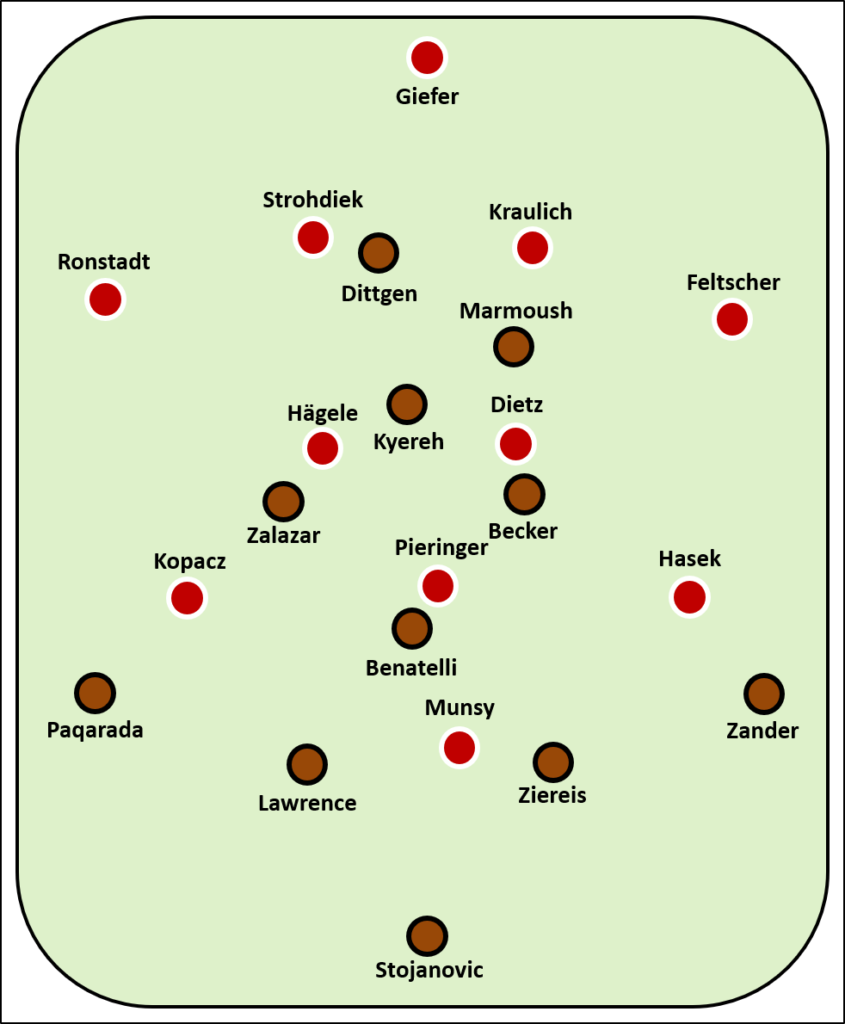
Es war nicht wirklich überraschend, dass Max Dittgen als nomineller Stürmer starten würde. Er hatte bereits im Test gegen Bielefeld auf dieser Position gespielt und auch zuletzt als Einwechselspieler dort agiert. Zusammen mit Omar Marmoush dürfte es sich um das schnellste Sturm-Duo der Liga handeln. Und dieses Tempo ist im Vergleich zu dem was die Defensive von Würzburg zu bieten hat ein ziemliches Mismatch aus Würzburger Sicht. Der FC St. Pauli spielte diese Tempo-Vorteile überragend aus.
Nominell stellten sich die Würzburger Kickers in einem 4-2-3-1 auf. War der FCSP im Ballbesitz rückte Pieringer mit vorne auf und die offensiven Außen fielen auf Höhe der beiden defensiven Mittelfeldspieler. So bildete sich ein 4-4-2. Zeitweise roch das ganze eher nach einer Dreierkette hinten, weil Frank Ronstadt als rechter Außenverteidiger zu Beginn auf Rodrigo Zalazar orientiert agierte und diesen anlief. Das wurde jedoch ganz schnell abgestellt, da der FC St. Pauli es im Spiel unter anderem genau auf die Räume hinter den Außenverteidigern abgesehen hatte.
Fünf Stürmer?
Das Sturm-Duo hieß zwar offiziell Dittgen und Marmoush, aber eigentlich waren beide eher Außenstürmer und es waren Daniel-Kofi Kyereh oder sogar Finn Ole Becker und Rodrigo Zalazar, die zentral einliefen. Die Offensiv-Formation des FC St. Pauli muss in diesem Spiel fast als 2-3-5 bezeichnet werden.
Denn so ordnete sich der FCSP bei Ballbesitz in der eigenen Defensive an. Aus dieser hohen Positionierung ließen sich dann immer zwei bis drei Spieler etwas tiefer in die eigenen Reihen fallen. Bestenfalls passierte das simultan zu einer tiefen Bewegung eines Mitspielers. Wenn sich also Omar Marmoush aus der hohen Position fallen ließ, dann startete Becker in eben jene Lücke ganz vorne rein. Ziemlich gut, nein richtig gut, ich würde sogar sagen überragend hat das Maximilian Dittgen gemacht. Der war für seine Gegenspieler eigentlich zu keinem Zeitpunkt zu fassen, besetzte auch gerne die Außenbahn und schuf so den Raum für Kyereh, der im Zentrum einlief. In vielen Momenten waren es auch diagonale Bälle, die Räume öffneten. Wenn man beim Spielaufbau des FCSP die Augen mal etwas vom Ball wegnimmt und auf die ballferne Seite achtet, dann fällt schnell auf, wie genau da auf offene Räume geachtet wird und wie schnell da der Laufweg in die Tiefe gesucht wird. Zusätzlich tauschten Marmoush und Dittgen ziemlich rege ihre Positionen und sie waren auch nicht dauerhaft nur für tiefe Läufe auf der Außenbahn und kurze Anspiele aus der Defensive zu haben. Auch sie suchten immer wieder den Weg in die Tiefe.
Die Beschreibung des Offensivspiels des FCSP liest sich bereits chaotisch. Aufgemalt sehen die ganzen Bewegungen nicht viel aufgeräumter aus:
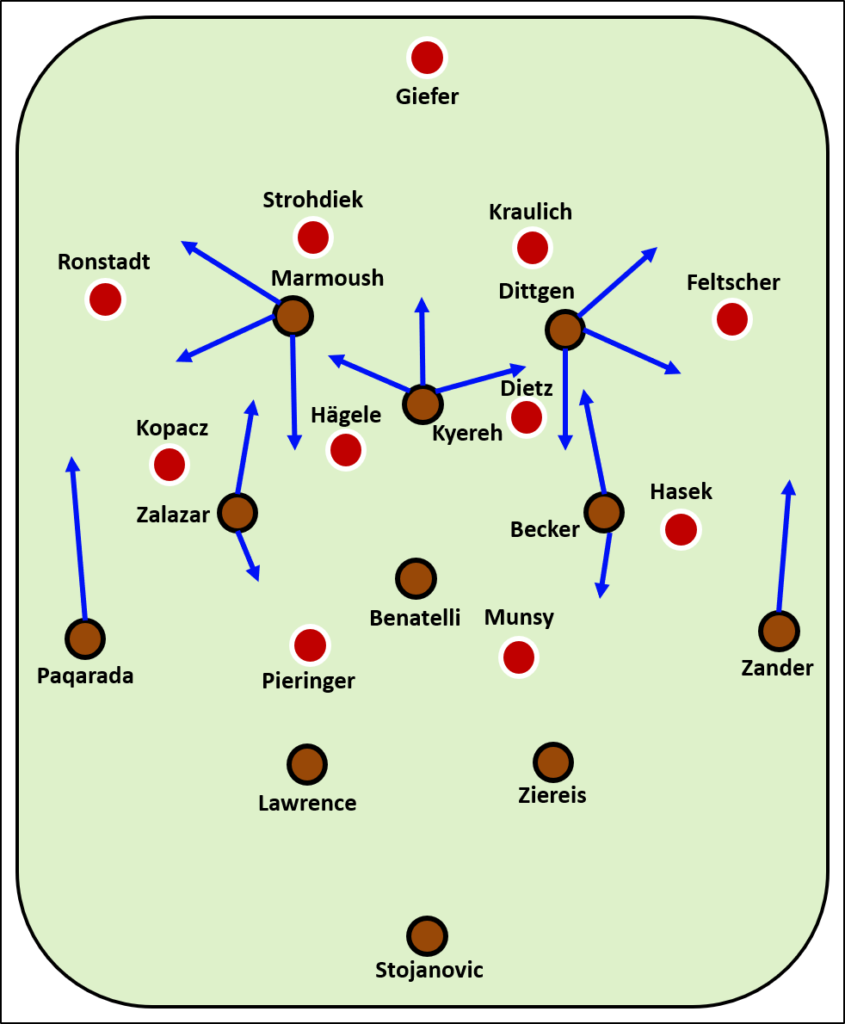
Wenn diese vielfältigen Bewegungen und Positionswechsel der FCSP-Offensive nichtmal in Ruhe verschriftlicht und verbildlicht werden können, wie zum Teufel soll die gegnerische Defensive im Spiel damit umgehen? Eintracht Braunschweig versuchte es mit starker Mannorientierung im Mittelfeld und scheiterte z.B. an der Dribbelstärke der FCSP-Spieler. Erzgebirge Aue versuchte das ganze eher im Raum zu verteidigen und scheiterte besonders an den Überzahlsituationen, die der FCSP auf den Außenbahnen schaffte. Die Würzburger Kickers schienen sich gar nicht mal so sicher, wie genau sie arbeiten wollten. Die anfängliche Mannorientierung (siehe Ronstadt auf Zalazar) war aufgrund der vielen Positionswechsel eher kontraproduktiv. Ehe da ein wirkungsvolles Konzept entwickelt werden konnte stand es bereits 0-3 aus Würzburger Sicht.
Aber mir fällt da auch momentan nichts zu ein, wie man den FCSP klug verteidigen kann. Daran scheitert aktuell Woche für Woche mindestens ein Team. Der FC St. Pauli ist in der Offensive einfach das wohl stärkste Team der Liga (diese Ansicht teilt auch FWK-Torhüter Fabian Giefer) und schlicht nicht vollumfänglich zu verteidigen. Auch in diesem Spielbericht kann ich es nur wieder erneut betonen: Diese Entwicklung ist großartig.
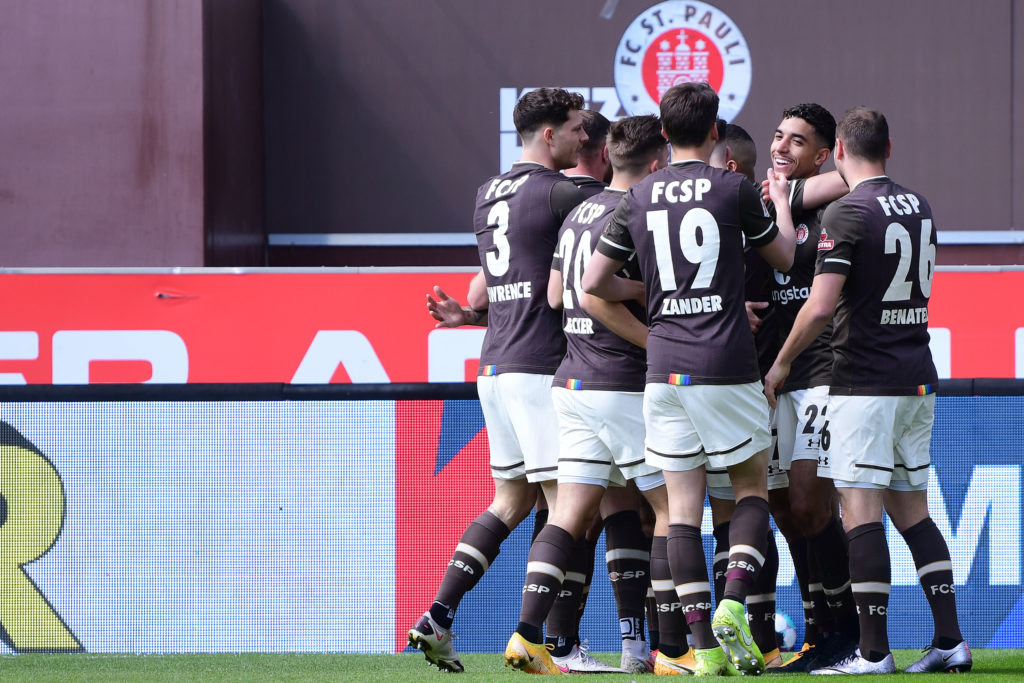
(c) Peter Böhmer
Gegenpressing? – Sogar noch besser!
Das Aufbauspiel gegen einen tiefstehenden Gegner hat sich im Saisonverlauf also stark verbessert. Die eigentlich stärkste Waffe wurde aber auch noch weiter verbessert: Die Würzburger Kickers brachten erst in der 17.Minute zum ersten Mal einen Pass im gegnerischen Drittel an den Mitspieler. Die meisten Bälle hat der FC St. Pauli vorher in einem brutalen Gegenpressing gewinnen können.
So entstand auch das 1-0 als Finn Ole Becker einen Querpass im Mittelfeld abfing und Marmoush damit auf die Reise schickte. Es sollte bei weitem nicht der einzige gute Ballgewinn durch gelungenes Gegenpressing sein. Ich bin mir manchmal nicht mal so sicher, ob der FCSP selbst am liebsten den Ball in der gegnerischen Hälfte hat oder ob er lieber zur Treibjagd nach Ballverlust rufen möchte. Es funktioniert auch einfach zu gut. Die beste Phase des Gegenpressing gab es als das Spiel schon längst entschieden war: Als beim Stand von 4-0 Daschner und Viet das Feld betraten, kam noch einmal richtig viel Tempo ins Spiel und die Würzburger Kickers dürfen sich bei der Ineffizienz des FCSP bedanken, dass sie nach 65 Minuten nicht sechs oder sieben Gegentore zu beklagen hatten.
In der Defensivarbeit waren beim FC St. Pauli noch weitere Veränderungen auffällig: Bisher wurden die gegnerischen Außenverteidiger immer direkt unter Druck gesetzt von den Halbpositionen des FCSP. Das war auch gestern so. Den Würzburger Außenverteidigern wurde aber häufig auch viel Zeit gelassen. Und dabei wurde ihnen meist genau eine einzige Passoption angeboten:
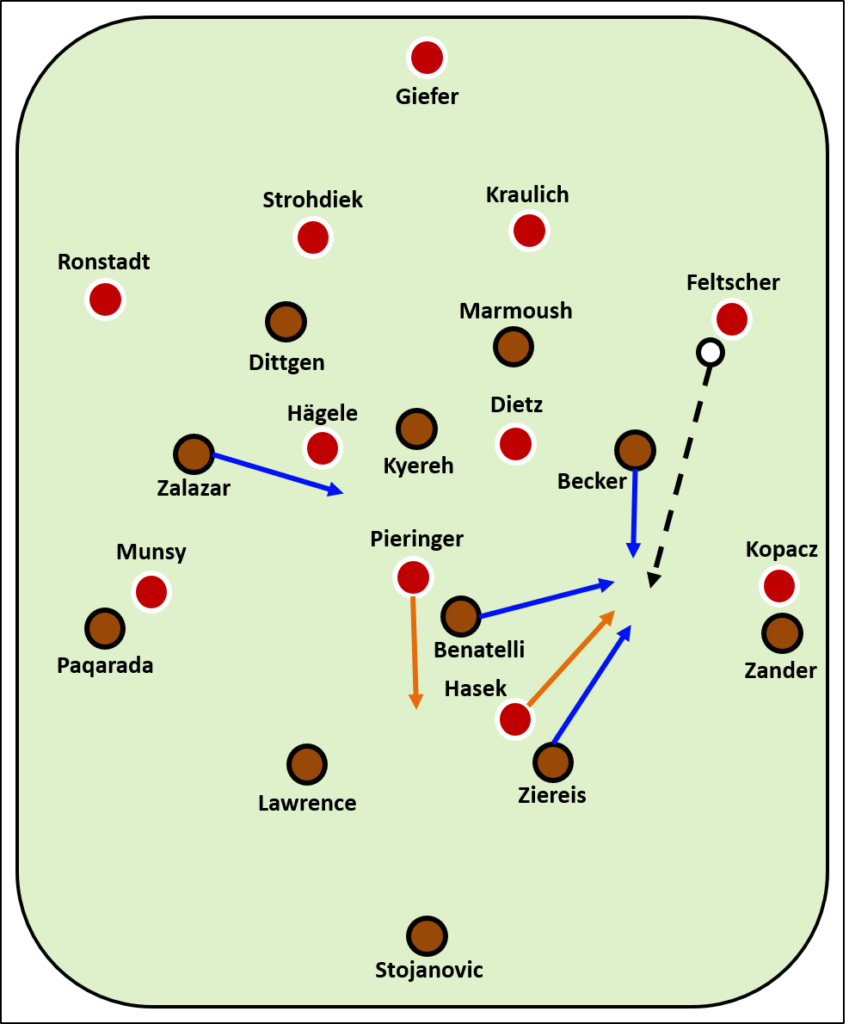
Der FC St. Pauli bot den Würzburgern einen Pass in den offensiven Halbraum an. Allerdings nur, um genau diesen Raum in Folge des Passes maximal zu verknappen und den Spieler dort direkt mit mehreren Spielern zu attackieren. Eine klassische Pressingsfalle, die gegen Würzburg einige Male zuschnappte.
Das 1-0 wurde also durch eine Umschaltaktion erzielt. Das zweite Tor entstand aus einer Ecke. Und ich möchte die Behauptung aufstellen, dass der FCSP in der Hinrunde so ein Tor wie Benatelli es zum 2-0 erzielte, nicht selbst gemacht sondern eher gefangen hätte. Die Raumaufteilung bei der Ecke passt natürlich ziemlich gut, aber dem FCSP fällt gleich zweimal ein offener Ball direkt vor die Füße.
Nur wenige Minuten später erzielt Leart Paqarada das 3-0 per ansehnlichem Fernschuss. Auch in dieser Situation passierte wohl nichts zufällig. Bereits die Bewegungen beim Einwurf sind einstudiert und glaubt mal ja nicht, dass Paqarada von selbst auf die Idee kommt sich bei einem eigenen Einwurf auf der gegenüberliegenden Seite zentral 25m vor dem gegnerischen Tor zu positionieren.
Mit dem 3-0 nach 22 Minuten war das Spiel entschieden. Ich habe keine Ahnung, ob ich schonmal zu so einem frühen Zeitpunkt ein für den FCSP entschiedenes Spiel gesehen habe (Erinnerungen dürfen in den Kommentaren gerne geteilt werden). In der Folge ließ der FCSP etwas nach und entfachte, wohl auch bewusst, nicht mehr ganz den großen Druck, sondern dominierte das Spiel aufgrund von viel Ballbesitz, ohne offensiv zu sehr ins Risiko zu gehen.
Die Würzburger Kickers hatten in der 36.Minute ihren ersten und einzigen Torschuss im gesamten Spiel. Dieser hatte einen xG-Wert von 0.03. Dem gegenüber stehen 2.16 vom FC St. Pauli und noch einige Situationen in denen sich der FCSP richtig gut bis vor das gegnerische Gehäuse kombinierte, aber nicht zum Torabschluss kam.
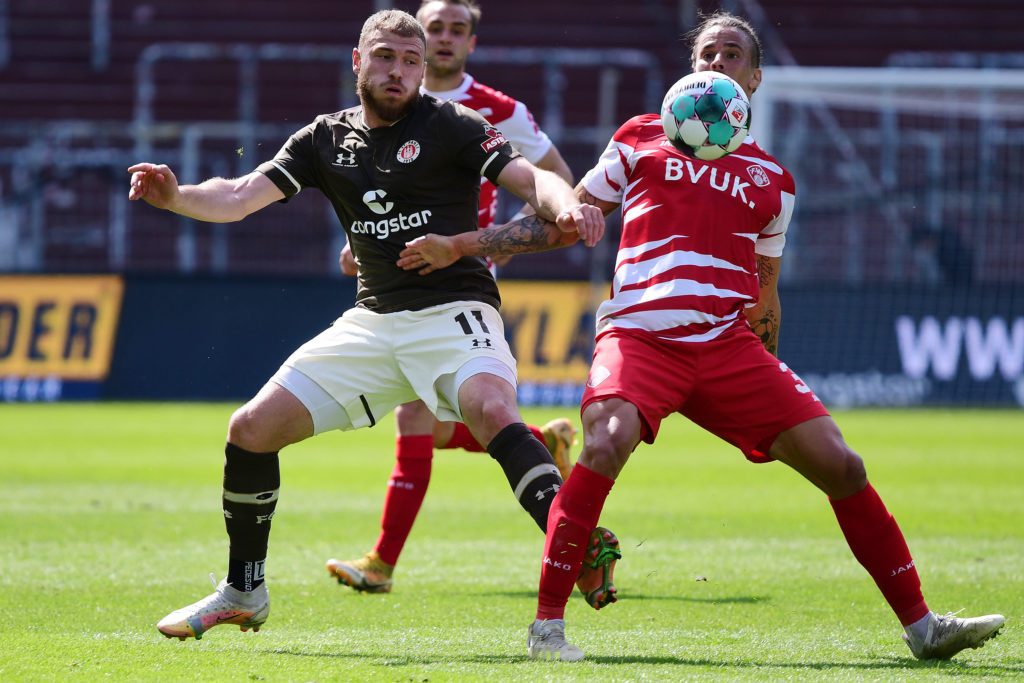
(c) Peter Böhmer
Statistisches
Die unfassbare Dominanz, die der FC St. Pauli das gesamte Spiel ausstrahlte, ist natürlich auch anhand einiger Statistiken zu erkennen:
Der FC St. Pauli toppte seine bereits hervorragenden Werte aus dem Spiel gegen Aue noch einmal, die ja bereits die Werte aus dem Braunschweig-Spiel toppten, und spielte 615 Pässe (530 erfolgreich – beides Saisonrekord).
Die 42 Positionsangriffe in 90 Minuten, zehn Torschüsse resultierten daraus, bedeuten ebenfalls einen Saisonrekord. Und zum ersten mal in dieser Saison verlor der FC St. Pauli weniger als 100x den Ball in einem Spiel (die 101 Ballverluste gegen Aue waren zuvor Saisonrekord).
Einen besonderen Fokus, der bei diesem Offensiv-Spektakel etwas kurz kommt, möchte ich noch setzen: Die Innenverteidigung des FC St. Pauli (Ziereis, Lawrence/Reginiussen) hat insgesamt nur einen einzigen Zweikampf verloren. Nur einen. Zusätzlich sind es eben jene Innenverteidiger gewesen, die den initialen Pass für die Angriffsaktionen des FCSP spielten (Reginiussen und Lawrence brachten alle ihre Pässe ins Angriffsdrittel an die Mitspieler). Vergleicht das mal mit 2020…
Wohin geht diese Reise?
Ganz ehrlich: Keine Ahnung. Könnte der FC St. Pauli die Leistungen aus den letzten Spielen konservieren, so wäre die Wahrscheinlichkeit recht hoch, dass sie auch die restlichen fünf Spiele gewinnen. Aber das ist ja bekanntlich nicht mal eben so möglich. Das Spiel nächsten Mittwoch gegen Düsseldorf dürfte aber in vielerlei Hinsicht für Klarheit sorgen. Die eigene Spielweise dürfte gegen Düsseldorf auf eine echte Bewährungsprobe gestellt werden. Denn das was Braunschweig, Osnabrück, Aue und Würzburg spielen wollen, aus einer tiefen Defensive heraus in Umschaltmomenten zu Torerfolgen zu kommen, spielt Düsseldorf in dieser Saison ziemlich erfolgreich. Und es dürfte nur mit einem Sieg weiter das Thema Aufstieg beim FCSP geben, vermutlich sogar stärker als zuvor. Auch deshalb, da am nächsten Wochenende Greuther Fürth ans Millerntor kommt.
Immer weiter vor!
// Tim
Alle Beiträge beim MillernTon sind gratis. Wir freuen uns aber sehr, wenn Du uns unterstützt.
MillernTon auf BlueSky // Mastodon // Facebook // Instagram // Threads // WhatsApp // YouTube
{:}{:en}Oh my goodness, I’m running out of superlatives! FC St. Pauli dismantled the Würzburg Kickers in less than 25 minutes. The game was controlled to the maximum and even though FC St. Pauli saved some energy, the Würzburg penalty area was always ablaze throughout the game. This difference in performance, this strength of the play of FC St. Pauli, is almost frightening, but they are the logical consequence of the development of the last matches. In this form, FCSP is not much less than the best team in the 2.Bundesliga.
(Cover picture: Peter Böhmer)
Line-up
Compared to the already convincing victory in Erzgebirge, FC St. Pauli changed two positions: Maximilian Dittgen replaced Guido Burgstaller, who had to miss the match for personal reasons. In central defence, James Lawrence returned from illness, so Adam Dźwigała had to make way.
On the other side, there were five changes: In goal, Fabian Giefer replaced regular goalkeeper Hendrik Bonmann. On the left side of defence, Arne Feick had to make way for Rolf Feltscher and further upfront, Marvin Pieringer and Martin Hašek replaced Dominic Baumann and Mitja Lotric. And then in defensive midfield, Patrick Sontheimer was missing due to yellow card suspension. He was replaced by Daniel Hägele.

It was not really surprising that Max Dittgen would start as the nominal striker. He had already played in this position in the test against Bielefeld and also acted there recently as a substitute. Together with Omar Marmoush, they are probably the fastest forward duo in the division. And this speed is quite a mismatch from Würzburg’s point of view compared to what their defence has to offer. FC St. Pauli played these tempo advantages in an outstanding manner.
Nominally, the Würzburg Kickers lined up in a 4-2-3-1. When FCSP were in possession, Pieringer moved up front and the attacking wingers fell in line with the two defensive midfielders. At times, it smelled more like a three-man backline, because Frank Ronstadt, at right-back, was oriented towards Rodrigo Zalazar at the start and ran into him. This was quickly stopped, however, as FC St. Pauli were targeting the spaces behind the wing-backs.
Five Forwards?
The forward duo was officially called Dittgen and Marmoush, but actually, both were rather outside forwards and it was Daniel-Kofi Kyereh or even Finn Ole Becker and Rodrigo Zalazar who entered centrally. FC St. Pauli’s offensive formation in this game almost has to be described as 2-3-5.
This is how FCSP arranged itself in its own defensive line when in possession of the ball. From this high position, two or three players always dropped a little deeper into their own ranks. At best, this happened simultaneously with a deep movement of a teammate. So when Omar Marmoush dropped from his high position, Becker started into that gap right in front. Maximilian Dittgen did a pretty good, no, really good, I would even say an outstanding job. His opponents couldn’t catch him at any time, and he was happy to occupy the flank and create space for Kyereh, who ran into the centre. In many moments it was also diagonal balls that opened up spaces. If you take your eyes off the ball for a while and look at the far side of the ball, you will quickly notice how carefully they look for open spaces and how quickly they look for deep runs. In addition, Marmoush and Dittgen swapped positions quite frequently and they were not always available only for deep runs on the flank and short passes from the defence. They also looked for the way into the depth again and again.
The description of FCSP’s offensive play already reads chaotic. Painted up, all the movements don’t look much tidier:

If these diverse movements and position changes of the FCSP offence cannot even be written down and visualised in peace, how the hell is the opposing defence supposed to deal with it in the game? Eintracht Braunschweig tried strong man-orientation in midfield and failed e.g. because of the dribbling strength of the FCSP players. Erzgebirge Aue tried to defend more in space and failed especially because of the outnumbering situations FCSP created on the outer lanes. The Würzburger Kickers didn’t seem at all sure how exactly they wanted to work. The initial man-orientation (see Ronstadt on Zalazar) was rather counterproductive due to the many position changes. Before an effective concept could be developed, it was already 0-3 from Würzburg’s point of view.
But I can’t think of anything at the moment to defend FCSP wisely. At least one team is currently failing week after week. FC St. Pauli is probably the strongest offensive team in the division (a view shared by FWK goalkeeper Fabian Giefer) and simply cannot be fully defended. In this match report, I can only emphasise it again: This development is great.

(c) Peter Böhmer
Counter-pressing? Even better than the rest!
The build-up play against a deeply positioned opponent has improved a lot during the season. However, the actual strongest weapon was also further improved: The Würzburg Kickers did not get a pass to their teammate in the opponent’s third for the first time until the 17th minute. FC St. Pauli won most of the balls beforehand in a brutal counter-pressing.
That’s how the 1-0 came about when Finn Ole Becker intercepted a crossfield pass and sent Marmoush on his way. It was by no means the only good ball won through successful counter-pressing. Sometimes I’m not even sure whether FCSP itself prefers to have the ball in the opponent’s half or whether it would rather call for a drive after losing the ball. It also just works too well. The best phase of the counter-pressing was when the game was already decided: When Daschner and Viet entered the field at 4-0, a lot of speed came into the game and the Würzburg Kickers can thank FCSP’s inefficiency that they didn’t have to lament six or seven goals conceded after 65 minutes. In the defensive work, FC St. Pauli made some other noticeable changes: Until now, the opposing full-backs were always put under direct pressure from FCSP’s half-positions. This was also the case yesterday. However, the Würzburg wing-backs were often given a lot of time. And they were usually offered exactly one single passing option:

FC St. Pauli offered Würzburg a pass into the offensive half-space. However, this was only done in order to constrict this space to the maximum and to attack the player there directly with several players. A classic pressing trap that snapped shut several times against Würzburg.
So the 1-0 was scored by a transition action. The second goal came from a corner. And I would like to make the claim that in the first half of the season, FCSP would not have scored a goal like the one Benatelli scored to make it 2-0, but rather would have caught it. Of course, the distribution of space at the corner fits pretty well, but FCSP gets an open ball right in front of their feet twice.
Only a few minutes later, Leart Paqarada scored the 3-0 with a nice long shot. In this situation, too, nothing happened by chance. The movements at the throw-in are already rehearsed and don’t think that Paqarada would come up with the idea of positioning himself centrally 25m in front of the opponent’s goal on his own throw-in on the opposite side.
With 3-0 after 22 minutes, the game was decided. I have no idea if I have ever seen a game decided for FCSP at such an early stage (feel free to share your memories in the comments). Subsequently, FCSP eased up a bit and, probably consciously, didn’t really put the pressure on, but dominated the game due to a lot of possession without taking too many offensive risks.
Würzburger Kickers had their first and only shot on goal in the entire match in the 36th minute. This had an xG value of 0.03. In contrast, FC St. Pauli had 2.16 and several other situations in which FCSP combined really well in front of the opponent’s goal but failed to score.

(c) Peter Böhmer
Statistics
The incredible dominance that FC St. Pauli exuded the entire match can of course also be seen in some of the statistics:
FC St. Pauli topped their already excellent stats from the game against Aue, which indeed already topped the stats from the Braunschweig game, and played 615 passes (530 successful – both season records).
The 42 positional attacks in 90 minutes, ten shots on goal resulted from them, also mean a season record. And for the first time this season, FC St. Pauli lost less than 100 times the ball in a match (the 101 ball losses against Aue were previously a season record).
I would like to add a special focus, which is somewhat neglected in this offensive spectacle: FC St. Pauli’s central defence (Ziereis, Lawrence/Reginiussen) lost only one one-on-one in total. Only one. In addition, it was precisely those centre-backs who played the initial pass for FCSP’s attacking actions (Reginiussen and Lawrence brought all their passes into the attacking third to their teammates). Compare that to 2020…
Where’s the journey heading to?
Honestly: I don’t know. If FC St. Pauli could conserve the performances of the last games, it would be pretty likely that they would also win the remaining five games. But as we all know, that’s not just possible. Next Wednesday’s game against Düsseldorf, however, should provide clarity in many respects. Their own style of play will be put to the test against Düsseldorf. Because what Braunschweig, Osnabrück, Aue and Würzburg want to play, i.e. to score goals from a deep defensive position in transitional moments, is what Düsseldorf is playing quite successfully this season. And there should only continue to be the topic of promotion at FCSP with a win, probably even stronger than before. Also because Greuther Fürth is coming to the Millerntor next weekend.
Keep on moving forward!
//Tim (translated by Arne)
MillernTon Twitter //
MillernTon YouTube //
MillernTon Facebook //MillernTon Instagram //
If you like what we do here, here you’ll find the information on how to support us.
{:}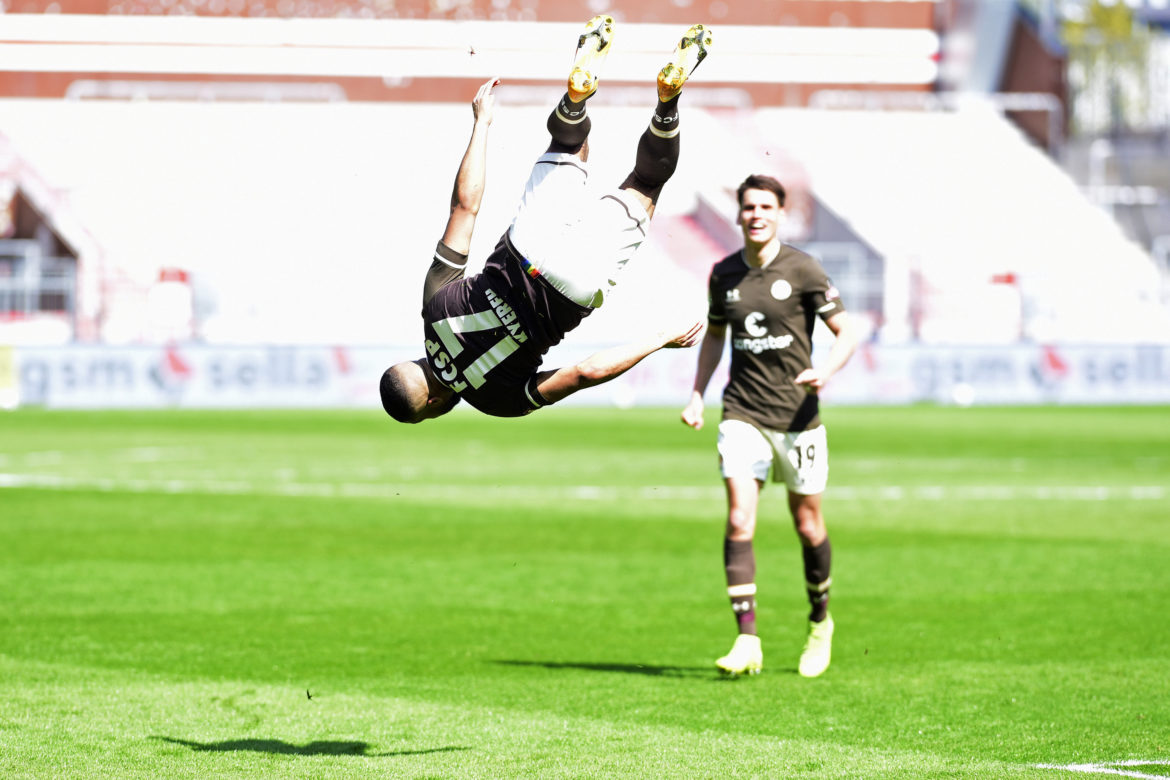

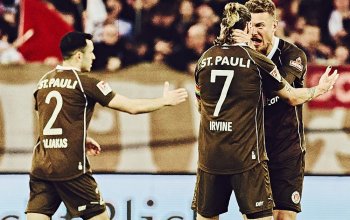
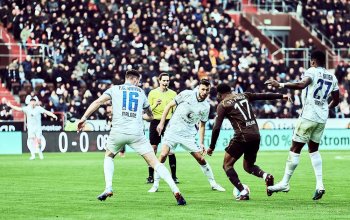

Danke! Es macht mir immer eine große Freude hier zu lesen.
Habt ihr über wyscout auch Zugriff auf Packingwerte? Da würden mich die Werte für unsere Innenverteidiger interessieren.
Leider nein. Packing-Daten gibt es nur direkt beim Erfinder, also bei Impect.
Danke Tim, wie immer lesenswert!
Wie erstellst du die „Taktikbilder“? Ist das ein bestimmtes Programm/ App?
Ähm… *hüstel… PowerPoint…
Ach stark, doch so simpel 🙂